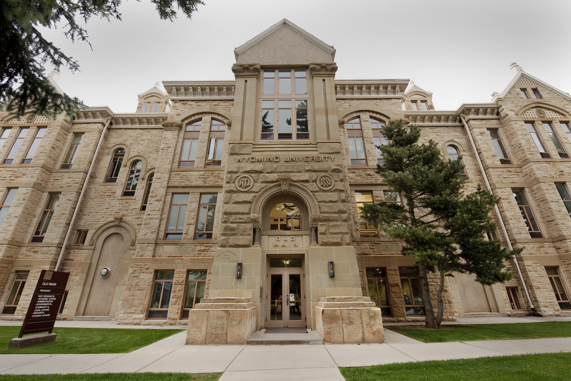
UW 10-27-20
In response to a 10 percent cut in state funding that resulted in an immediate reduced distribution from the state earlier this year, the University of Wyoming’s administration has identified a plan to address a $42.3 million budget reduction in the current biennium to present to the UW Board of Trustees.
At the same time, units of the university are preparing for further analysis this fall to guide additional, strategic reductions that will allow progress on priority projects focused on partnerships and collaborations aimed at boosting Wyoming’s economy — and to address any further cuts in state funding.
In accordance with UW Regulation 2-12, the university’s administration is presenting the budget reduction allocation proposal for the current biennium to receive input from faculty, staff, students and the public. President Ed Seidel was directed by the Board of Trustees to propose a budget reduction plan for the board’s consideration at its Nov. 11-13 meeting, as a result of the cuts imposed by Gov. Mark Gordon in response to a dramatic downturn in state revenue.
“Any cut of this magnitude is difficult, but we believe we have a specific plan to achieve this reduction by finding new efficiencies and eliminating some programs that don’t align with our strategic priorities,” Seidel says. “We aim to minimize the impact to our students; optimize the research we conduct to boost our state’s economy; and strengthen the service we perform for the citizens of Wyoming. This positions the university to develop plans that will, over the long term, enable us to become a best-in-class 21st century land-grant university true to its Wyoming roots.”
The budget reduction plan touches both academic and nonacademic units of the university. At least 78 positions, most of them currently unfilled, would be eliminated.
On the academic side, UW primarily would use cash savings realized from the elimination of positions captured through attrition for fiscal year 2021 reductions. Additionally, the colleges and schools would reduce their support budgets — including travel and professional development — and operations budgets, as well as using staff vacancies. The cuts would eliminate 50 currently budgeted positions.
On the nonacademic side, the university would eliminate another 28 budgeted positions. Housing, dining, catering and conferences would be reorganized for greater efficiency and productivity. The Department of Athletics would reduce salaries and cut team travel costs. The Office of the Provost would cut about 35 graduate teaching assistant positions and reduce spending on enrollment management and global engagement.
In concert with the budget reduction proposal, 20 low-enrollment academic programs have been identified for review for potential reorganization, consolidation, reduction or discontinuance — with the potential to save $2.5 million annually. They include:
— In the College of Agriculture and Natural Resources, the Master of Science and Ph.D. programs in agronomy would be eliminated, and the community development concentration in agricultural economics would be refocused to more closely align with the strategic plan.
— In the College of Arts and Sciences, the bachelor’s and master’s degree programs and minor in American studies; the Master of Arts in psychology; the Bachelor of Science in journalism; the Master of Science in Teaching in chemistry; the Master of Arts in Teaching in history; and the Master of Fine Arts program in creative writing would be eliminated.
— In the College of Business, minors in accounting, decision science, finance, human resource management and marketing would be eliminated; and the Master of Business Administration energy concentration would be suspended. Additionally, the business administration online bachelor’s program would be replaced with a human resources management online program.
— In the College of Education, the bachelor’s program in secondary French, German and Spanish education would be eliminated.
— In the College of Engineering and Applied Science, consolidation of the Department of Electrical and Computer Engineering and the Department of Computer Science would be considered.
— In the College of Health Sciences, several curricula would be overhauled.
— In the College of Law, the military justice/Judge Advocate General’s (JAG) Corps track and the Summer Trial Institute would be eliminated.
Academic program reorganizations, consolidations, reductions and discontinuances are governed by UW Regulation 2-13, which requires a maximum 120-day period of review to seek feedback from stakeholders including the Faculty Senate, the Staff Senate, the Associated Students of UW and other interested parties. Under that timeline, the finalized academic reductions are slated to be presented to the trustees in February.
The budget reduction plan was informed by the work of UW’s Budget Reduction Working Group (BRWG), which includes administrators and representatives of faculty, staff and students. The BRWG conducted numerous listening sessions with faculty and staff members across the university this fall.
In addition to the plan for reductions for the current biennium, UW leaders are moving forward with a deeper analysis of the university’s academic programs to free up resources to advance the university’s “four pillars” priorities of becoming more digital, more entrepreneurial, more interdisciplinary and more inclusive. Proposed reorganizations, consolidations, reductions and discontinuances resulting from that analysis would be initiated under UW Regulation 2-13 next spring or summer.
This will be done in concert with a strategic planning process, including the appointment of a strategic planning leadership council.
“It will take time and deep faculty discussion and administrative discussions to effectively pivot the university through shared governance processes toward a new vision,” Seidel says. “The university is committed collectively to making decisions to prioritize specific programs for growth; others for elimination or consolidation; and creating new programs that may be needed to realize our common goals. This will be carried out in conjunction with known university processes for program revision and strategic planning.”
Seidel and other UW leaders are working with the state’s community colleges, other state and federal agencies, private entities and others to develop programs and partnerships to propel the state’s economy through technological innovation and workforce development. Some of these will require a reallocation of university resources, in addition to new external sources of funding.
“Over time, if we invest selectively, and we develop programs and partnerships across the state with these qualities in mind, we can transform the university, even during a time of budget cuts,” Seidel says. “We intend to be very strategic, cut where things do not contribute to the above themes, or where they are stale or not growing, and selectively invest where they do. Ultimately, we’re working to help be part of the solution to lay the foundation for the new economy of the state.”
